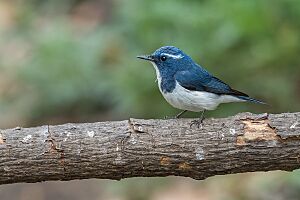Ultramarine flycatcher facts for kids
Quick facts for kids Ultramarine flycatcher |
|
|---|---|
 |
|
| Male from Pangot village of Nainital district of Uttarakhand, India | |
| Conservation status | |
| Scientific classification | |
| Genus: |
Ficedula
|
| Species: |
superciliaris
|
The ultramarine flycatcher, also known as the white-browed blue flycatcher, is a small bird. Its scientific name is Ficedula superciliaris. This bird belongs to a group called "Old World flycatchers." It lives in trees and spends its summers in the Himalayas. When winter comes, it flies south to India.
Contents
What Does the Ultramarine Flycatcher Look Like?
This bird is a bit smaller than a regular sparrow, usually about 10 centimeters long. It has a strong, sturdy body.
Male ultramarine flycatchers are a beautiful deep blue color on their backs, heads, and necks. They have a bright white patch that starts under their chin and goes down to their belly.
The amount of white on their eyebrows and tail feathers can be different depending on where they live. Scientists sometimes use these differences to tell apart three types of this bird:
- The western type, found in the western Himalayas, has a clear white stripe above its eye. It also has white at the base of its outer tail feathers.
- The eastern type (called Ficedula superciliaris aestigma) lives in the eastern Himalayas. It does not have these distinct white patches.
- A third group, found in the south Assam hills, has no white eyebrow stripe at all.
These birds usually fly alone. However, in winter, you might see them joining other bird groups to hunt for food. They tend to stay hidden in low trees and bushes, looking for insects among the leaves. They don't often fly out into open spaces.
The ultramarine flycatcher often bobs its tail up and down. It might also fluff up the feathers on its head and make a soft "trrr" sound. This often happens when it is near its nest. Their main food is insects.
Where Do Ultramarine Flycatchers Live?
Ultramarine flycatchers live in different places depending on the season.
Summer Homes (Breeding Areas)
During the summer, these birds are common visitors to the western Himalayas. You can find them from Jammu and Kashmir and Himachal Pradesh to Uttarakhand. The eastern type of the bird lives in the eastern Himalayas, from Nepal through Bhutan to Arunachal Pradesh.
They usually build their nests and raise their young at heights between 2,000 and 2,700 meters. Sometimes, they can be found as low as 1,800 meters or as high as 3,200 meters.
They also live in the lower hills of Meghalaya and Nagaland, including the Khasi and Cachar hills. We don't know much about where these specific birds go in winter.
Their favorite places to live are open forests with a mix of trees like oak, rhododendron, pine, and fir. Sometimes, they even live in fruit orchards.
Winter Homes
When winter arrives, ultramarine flycatchers fly south to warmer areas. They can be found in central India, from Delhi down to northern Maharashtra and Goa. They also travel eastward to Andhra Pradesh and Odisha.
Some birds that spend winter in the eastern states might come from Nepal or Sikkim. These groups often include birds with white eyebrows and tail patches. Sometimes, an ultramarine flycatcher might even wander into the northern part of Bangladesh.
Nesting and Reproduction
Ultramarine flycatchers build their nests and lay eggs from mid-April to early July.
Building the Nest
- Their nests are soft and made from fine moss, strips of bark, and thin grass.
- They line the inside with hair and tiny roots to make it cozy.
- Nests are usually placed in holes or cracks in trees, up to seven meters high.
- Sometimes, they build nests in a dip on a steep bank.
- They are also happy to use nest boxes that people put out in gardens, especially in hill stations.
Eggs
- A female ultramarine flycatcher usually lays 3 to 5 eggs, but most often 4.
- The eggs can be olive green or a dull stone-buff color.
- They are covered with small reddish-brown spots.
- Sometimes, the spots are mostly around the wider end of the egg, forming a cap.
- On average, the eggs are about 16 millimeters long and 12.2 millimeters wide.
How Ultramarine Flycatchers Find Food
When these birds look for food, they are very careful. They often pay attention to small clues around them rather than just looking directly at insects. This helps them stay safe while they are busy finding their next meal.
Gallery
-
Male from Himachal Pradesh, India
-
Male from Phoolchoki Forest, Godawari, Lalitpur Nepal.







